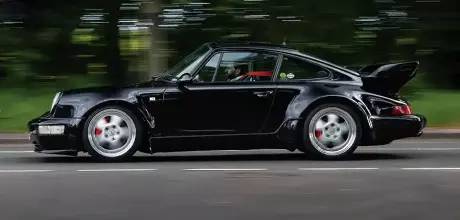415bhp 1992 Porsche 911 Turbo 3.6 964 converted to BTR 3.8 spec
Fast, rare and highly respected, this RUF BTR 3.8 conversion is a 964 Turbo 3.6 on steroids…
Words Dan Furr and Emma Woodcock
Photography Dan Sherwood
RAISING THE RUF
A 415bhp 1992 Porsche 911 Turbo 3.6 964 converted to BTR 3.8 spec.
Upright windscreen, round headlights and an accelerating, sloping rear, intermingled with a high-rise, twinplane rear wing. A ride height almost skimming the floor and wheel arches shouldering far out from bodywork.
The shape is unmistakably a 964-generation 911, but the additions suggest something far removed from a basic Carrera. Look closer and a firmer idea forms. With deep side skirts and a pair of front bumper cooling vents, this car is wearing a factory Porsche Aero kit. Add the stripped interior and it must be one of the rarest limited editions. Something like a Carrera RS 3.8 or Turbo S 3.3?
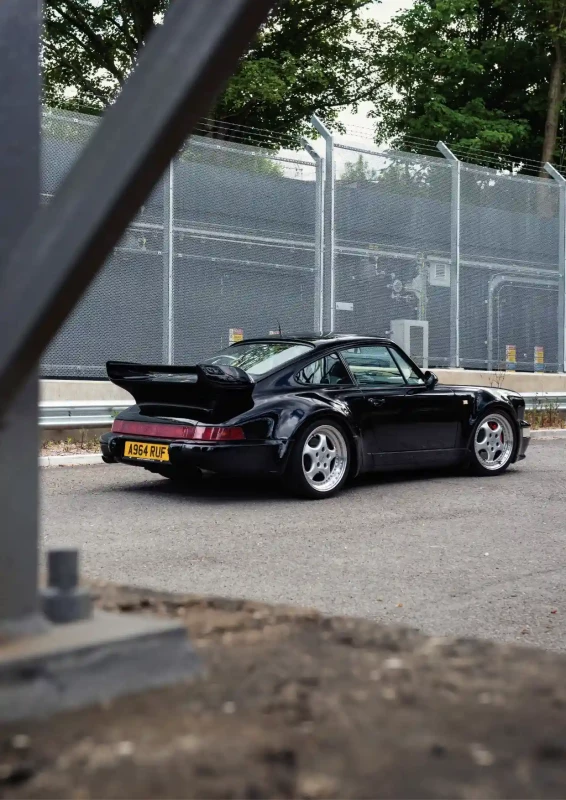
IMMEDIATE AND SCINTILLATING, YET PERFECTLY CONTENT TO CRUISE FOR HOURS, THE BTR 3.8 IS REMARKABLE
The badge on the nose disagrees. This isn’t a Porsche at all — it’s a RUF. Engineered in Pfaffenhausen, barely a hundred miles from Zuffenhausen, this 415bhp BTR 3.8 is far removed from Porsche factory specification, but the car wasn’t always this way. Though Alois Ruf Jr (one of the world’s most respected and enduring Porsche tuners) converted several 964 Turbos to BTR 3.8 specification before they’d even turned a wheel, this example was converted much later in life. Indeed, up until 1998, the wide-hipped, gloss black machine was a doppelgänger for Will Smith’s ride in action flick, Bad Boys, and carried standard 964 Turbo 3.6 specification to match.
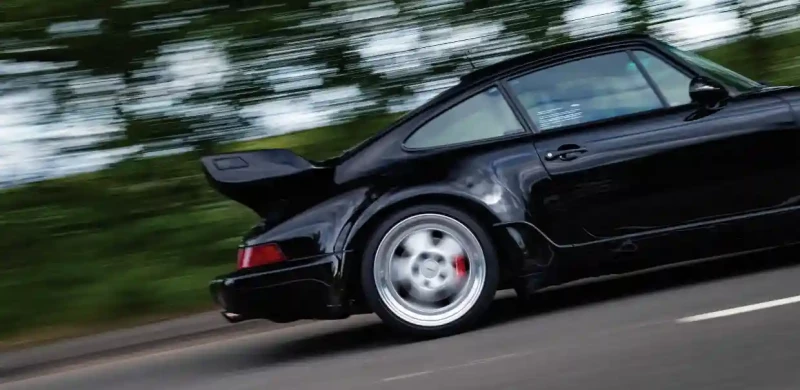
Successor to the long-lived 911 Turbo (930), the 964 Turbo followed a similar template upon its introduction in 1990. Power comes from a revised version of the 3.3-litre engine powering the 930, while cog-swapping is managed by the familiar G50 five-speed manual gearbox, which sends drive directly to the rear wheels. A substantial rear wing and wide rear arches provide visual clout. Detail changes are more substantial and follow the rest of the 964 range, providing anti-lock brakes, powerassisted steering, coil suspension throughout and even a revised heater. With a larger turbocharger than that of the 930, the 964 Turbo brings improved performance, delivering 315bhp and 332lb-ft torque.
IMMEDIATE AND SCINTILLATING, YET PERFECTLY CONTENT TO CRUISE FOR HOURS, THE BTR 3.8 IS REMARKABLE
With the release of the 911 Turbo 3.6 in 1992, Porsche refined the 964 Turbo concept and raised power. Increases to the bore, stroke and compression ratio yielded 355bhp and 384lb-ft peak outputs. Taking inspiration from the limited edition 964 Turbo S 3.3, the Turbo 3.6 also benefits from eighteen-inch Speedline three-piece split rims (offering eight inches of width at the front, ten at the rear) and drilled brake discs. Firmer springs, a front strut brace and a ride height twenty millimetres lower than the standard 964 Turbo complete the transformation.
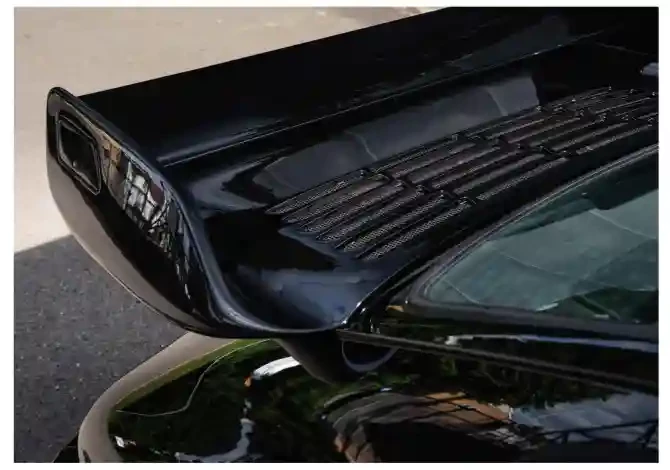
Buyers had to act fast. With the 993-generation 911 set to arrive in 1994 — and the corresponding four-wheel drive 911 993 Turbo planned for release the year after — the 964 Turbo 3.6 was on sale for a short time, until the 964 range was withdrawn in late 1993. Porsche sold just 1,437 examples of the Turbo 3.6, making it one of the most sought-after air-cooled 911s.
One final development of the 964 Turbo 3.6 concept rounded out production: the 964 Turbo S 3.6. Equipped with a larger turbocharger, revised camshafts, altered cylinder heads and an additional oil cooler, this special edition model produces 385bhp and stands as the fastest production 964. A ZF twenty-percent locking limited-slip differential and revised spoilers (front and rear) also feature. Only ninety cars appeared in Turbo S 3.6 trim, seventy-six of which received striking flachbau bodywork with pop-up headlights. Boutique and brutal, this is the ultimate factory interpretation of the 964.
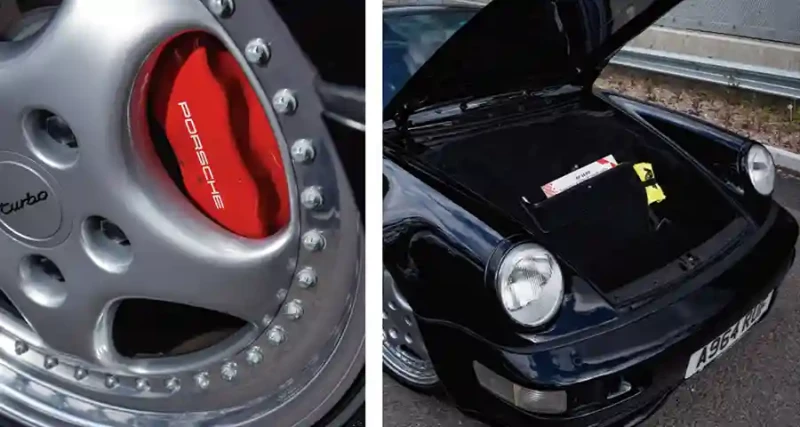
Alois Ruf Jr and his team went further still, releasing the BTR 3.8 in 1992. The first RUF model based around the revised 964 platform, it replaces the earlier 3.4-litre BTR (the first RUF production sports car with a RUF-specific VIN) and is positioned just below the iconic CTR ‘Yellowbird’ of 1987. Like those models, the BTR 3.8 boasts a turbocharged and substantially redesigned flat-six, extensively customised running gear and almost unbelievable performance, with RUF claiming 198mph top speed. Independent testing shows the figure to be pessimistic, with Road & Track managing 205mph and an 11.9-second quarter-mile.
As those numbers show, RUF showcased much of its expertise in the BTR 3.8’s engine. Starting with a standard 3.6-litre Porsche flat-six, the RUF team revised the camshafts, installed new head gaskets, raised compression ratio and increased cylinder bore to 102mm, hiking overall displacement to 3,746cc. Improved airflow and Motronic sequential fuel injection also feature, ensuring the BTR 3.8 has the raw ingredients necessary to create its monstrous 406lb-ft torque.
Every BTR 3.8 built at the RUF facility benefits from the narrow-body 964 Carrera 2 bodyshell, which, when combined with a rigorous weight saving regimen (not limited to removing the rear seats and much of the electronics, as well as swapping the Porsche steering wheel for a three-spoke RUF item and installing lightweight bucket seats), trims overall mass to just 1,260kg. That’s more than two hundred kilograms less than a standard 964 Turbo and only thirty kilos more than the lightweight 964 Carrera RS. As a converted 964 Turbo 3.6, the gorgeous black 911 in our photos incorporates the same RUF cabin — including integral roll cage — into a wide-track bodyshell and features a genuine 964 Carrera RS 3.8 Aero kit.
Stiffened suspension and more assertive brakes also appear in the BTR 3.8 package, yet it’s the transmission that really sets the RUF apart from contemporary Porsches. Every BTR 3.8 uses a limited-slip differential with a substantial forty-percent locking ratio — improving traction even in extreme conditions — and drives through a bespoke RUF six-speed gearbox. Developed from the five-speed unit used in period 911s, the transmission appeared in several RUFs, along with the company’s innovative system Electronic Clutch System (EKS), which matches an H-pattern shifter with an automatic and electronically controlled clutch, thereby removing the host vehicle’s “tiresome clutch pedal”. Our black car has a more conventional three-pedal setup.
What’s in a name, though? RUF is about to enter is eighty-fifth year and can count far more than the BTR 3.8 as its contribution to automotive innovation. Eight minutes and five seconds isn’t an astonishingly quick Nordschleife lap time by today’s standards, but how it was achieved has been entrenched in automotive folklore since 1987, when the CTR set a hot lap at the Green Hell. Test driver, Stefan Roser, exhibited awesome control of the sliding yellow monster, establishing RUF as a Porsche-tuning powerhouse as he belted along the 12.93-mile circuit. The story of the Pfaffenhausen-based outfit started almost fifty years earlier, though.
In 1939, Alois Ruf Sr opened Auto RUF, a general, allvehicle service garage. By 1949, the business included a fuel filling station. Far from the Porsche-based sports cars RUF is associated with today, the first vehicle Alois Sr built was a tourist bus. Surfing the rise of the travel age, the people carrier proved popular enough for a separate RUF bus company to be established in the late 1950s. Alois Jr watched the steady expansion of his father’s business and, by the close of the 1960s, was permitted to service and repair Porsches from its Pfaffenhausen workshops. Sadly, in 1974, Alois Sr passed away, leaving twenty-four-year-old Alois Jr to take control of the family firm.
The 911 had captured his heart. It came as little surprise to friends of the Ruf family when, within twelve months of stepping into Alois Sr’s sizeable shoes, Alois Jr presented the first RUF-tuned 911, a tweaked and tuned air-cooled sports machine paving the way for a string of ground-breaking technological developments. Two years later, the RUF Turbo featured an enlarged 3.3-litre engine and beat Porsche’s own 911 Turbo (930) 3.3 into construction by a year. A distinct increase in performance was inevitable through uprated fuel injection, revised airflow and modified engine internals.
The 300bhp firecracker sent power to the rear wheels via a bespoke five-speed gearbox. This was another Zuffenhausen-beating development, with the 930 not benefiting from the same number of cogs until 1989. RUF wasn’t only concerned with tuning turbocharged Porsches, though. The SCR of 1978 was the company’s first normally aspirated performance offering. Based on the 911 SC, the 3.2-litre, 214bhp monster was up 37bhp and proved to be a hit. Indeed, in light of strong customer demand, RUF was recognised as an independent manufacturer three years later, affording Alois Jr the opportunity to take unmarked Porsche chassis and stamp them with RUFspecific vehicle identification numbers. The milestone was celebrated with 1983’s 930-influenced BTR (Gruppe B Turbo RUF), RUF’s first official production car and one carrying a name inspired by the Group B motorsport machines of the day.

Available in narrow or wide-body format, each BTR was constructed from a bare Porsche chassis and was powered by a 369bhp 3.4-litre turbocharged flat-six. A fearsome 350lb-ft torque flooded in at 4,800rpm. Performance was brutal. Car & Driver magazine timed the car from rest to 60mph at 4.3 seconds. Top speed was recorded at 190mph. Following testing in 1984, Road & Track crowned RUF’s ballistic baby the world’s fastest production car. Three years later, the same test BTR, complete with an odometer showing more than 211,000 miles covered, was pitched against a selection of other exotic European sports cars, including the Lamborghini Countach 5000 QV, the Mercedes AMG W124 300 E ‘Hammer’, the Ferrari 288 GTO and the same manufacturer’s Testarossa. The RUF convincingly outperformed each of these much newer creations. Later, the model was upgraded with a 409bhp 3.8-litre engine before the arrival of the BTR2, a 993-based build chucking out 414bhp. A turbocharged 993 built in tribute to the original BTR and pre-dating Porsche’s own turbocharged 993 by two years was impressive enough, but as RUF had already demonstrated, the company was no stranger to creating iconic sports cars.
RUF’s ‘hit single’ is unquestionably the aforementioned CTR. Built on the Carrera 3.2 platform, the distinctive ‘race car for the road’ was equipped with aluminium body panels, a de-seamed shell and fibreglass bumpers working to reducing drag. Air was savagely sucked into the twin-turbocharged 3.4-litre engine’s intercoolers through ducts in the rear quarters. Seventeen-inch Speedline five-spokes covered Brembo stoppers loaded with 330mm rotors, while an integrated roll cage added to the CTR’s motorsport-themed trim. 462bhp was the headline figure, managed by a custom-ratio five-speed transmission planting power to the asphalt through specially developed Dunlop run-flats.
Like the BTR before it, the CTR was confirmed as the world’s fastest production car. The title came after a run at the Nardo Ring in Italy, where the rampant RUF screamed to 60mph from a standing start in just 3.65 seconds, romping on to a staggering 213mph. Road & Track nicknamed the CTR as ‘Yellowbird’ due to its eye-popping paintwork contrasting against leaden sky on the day of the test. Such is popularity of the label, many people think it to be an official RUF nameplate. It has certainly stuck, much like the canary-chirp from the CTR’s blow-off valve. At $223k, this car wasn’t cheap, but it smashed the 444bhp 959’s zero-to-100mph time and held the unofficial Nürburgring lap record for many years. Footage of this particular Green Hell time trial is as famous as the car itself.
Despite only twenty-nine CTRs rolling off RUF’s Pfaffenhausen production line (less than thirty more were converted customer cars using CTR trim), the model comprehensively reshaped the supercar landscape. The revolutionary RUF’s prominent appearance in numerous computer racing simulators, including Gran Turismo and Forza, influenced successive generations of adolescent petrolheads. The CTR legend was well and truly forged, and Alois Jr knew the company bearing his name would need an even more extreme car to fill the void when production ended as 1996 drew near.
The CTR’s successor was the imaginatively named CTR2, a 513bhp 993-based RUF packing a 962-derived flat-six delivering a knockout punch to the Ferrari F50 and Jaguar XJ220. An integrated roll cage, carbonceramic brakes, coilovers and forged magnesium rims were offered as part of the package. Again, RUF celebrated another of its creations being hailed as the world’s fastest production sports car, with the CTR2’s 220mph top speed beaten only by the mega-money McLaren F1 three years later. Today, the CTR2 is respected as one of the most important non- Zuffenhausen Porsches of the 1990s.
Based on the mid-engined R50 prototype, the 691bhp twin-turbocharged CTR3 was unveiled at the opening at RUF’s new factory at Bahrain International Circuit in 2007. The event took place on the twentieth anniversary of the original CTR’s release into the wild and debuted a RUF-designed body with a chassis co-engineered by Canadian automotive engineering firm, Multimatic. The CTR3 was intended to reflect the style of classic Le Mans race cars, although anyone familiar with the Porsche product range will recognise elements of 987 Cayman and 997 Turbo in the presented design. Equipped with a transversely-mounted six-speed sequential gearbox, the CTR3’s frame was constructed from aluminium and zinc-dipped steel with a rear spaceframe around the engine. This part of the car is referred to by RUF as the CTR3’s ‘birdcage’.
Debuting as a concept in 2017, the CTR Anniversary celebrates three decades of the record-breaking model setting the automotive world alight in 1987. Staying true to RUF’s most famous creation, this digital-generation CTR features looks echoing styling cues adopted years earlier, but don’t be fooled into thinking the newer car is based on a 911. Instead, it rides on RUF’s first inhouse developed chassis, a design progressed from the manufacturer’s 964-based 590bhp Ultimate model of 2016. The CTR Anniversary, however, is built around a largely carbon-fibre monocoque mated to a 700bhp dry-sumped 3.6-litre flat-six with twin turbochargers. The dash to 62mph from rest is completed in 3.5 seconds. 125mph is reached in nine seconds dead. In keeping with the original CTR’s super-low production volume, only thirty CTR Anniversaries were scheduled for assembly.
NEXT GENERATION
Updating RUF’s first normally aspirated concept in a similar way, the latest SCR’s calling card is its 964 looks and powerful flat-six free of forced induction. Born from the whale-tailed, 993-based, carbon-clad SCR 4.2 prototype of 2016 — a 964-aping RUF loaded with a water-cooled 997 GT3 ‘Mezger’ engine featuring increased displacement — the newer SCR produces 503bhp from a four-litre powerplant. A steel roll cage is integrated into the model’s carbon monocoque, Sachs coilovers with remote reservoirs ensure handling is super-focused, while carbon-ceramic six-piston brakes bring the car to a sudden halt after it has rocketed to a top speed of 199mph. Sticking with tradition, RUF limited production to only fifteen units per year.
It’s not just the 911 which has captured the imaginations of Alois Jr and RUF engineers. The introduction of water-cooled Porsches gave Boxster fanciers the 310bhp 996-engined 3400S roadster in 1999. The 3600S and 3800S packed additional power, while the more exclusive RK Coupe (and its Spyder variant) was a collaboration between RUF and Italian coachbuilder, Studiotorino. And if RUF enthusiasts like the idea of owning a Pffafenhausen creation, but find themselves in need of more than two seats, the Cayenne Turbo S-based RUF Dakara of 2009 is a super-SUV producing 591bhp from its 4.5-litre V8. It was, however, the 911 which captured Alois Jr’s heart, and it continues to be 911-based builds which have been at the core of his company’s output since he took control of the reins almost fifty years ago. The 365bhp RUF Carrera Turbo (RCT) burst onto the scene back in 1993, and its 419bhp RCT Evo successor currently caters for those interested in 964-based fun through RUF’s Modern Classics range. The currently available 484bhp 993-based Turbo R picks up where the original RUF Turbo R left off (after just one year of production in 1998), while numerous RUF RGTs based on 996, 997 and 991 chassis promise a huge helping of normally aspirated fun on four wheels.
Marrying retro styling with modest modern power, the 168bhp RUF R56 takes the 356 platform and equips it with a modified flat-four, but for those who lust for a far higher number of ponies, the 791bhp 991-based RTR, the 720bhp RT12 R and the RGT-8 (the later being the first 911-based production car powered by a V8 engine) deliver immense performance in what we’ve come to regard as Pfaffenhausen tradition. There’s a 636bhp Targa-roofed Turbo Florio too, but as RUF charges into the future, Alois Jr has acknowledged forthcoming production will result in cars embracing the electrification — more than a decade ago, the eRUF, eRUF Roadster and Cayenne-platformed Stormster concepts confirmed RUF is ahead of the curve when it comes to planning for the seismic shift in the way cars are powered. In the here and now, however, we get to bask in the glory of this 964 Turbo 3.6, upgraded to BTR 3.8 specification. Only a fortunate few have dropped into the RUF-designed seat and experienced a BTR 3.8 for themselves. One previous owner of this example — who bought the car when looking for an original 964 Turbo – reports a drive like little else. Mixing over four hundred horses with turbocharged delivery, rear-wheel drive and archetypal rear-engined handling, first impressions of the BTR 3.8 sit between phenomenal and genuinely scary.
The enlarged engine sits at the heart of the experience, defining the car. Rocket sled acceleration is always on offer — allowing safe overtakes on all but the shortest straights — but there’s flexibility at lower revs and smaller throttle openings, too. Usable performance is available in almost every scenario, turbocharger lag rarely disrupting the flow, though the previous owner counsels caution and measured inputs. Put it this way, he never took his BTR 3.8 out in wet weather. As confidence grows, the RUF begins to reveal new layers of involvement. Serpentine asphalt reveals unimpeachable grip and sharp steering, the revised suspension placing the BTR 3.8 with greater accuracy than an original 964 Turbo can muster, while the RUF six-speed gearbox rewards with a tight, precise shift. Crack the window and there’s aural excitement too, the oversized flat-six screaming and spooling with each new input.
Immediate and scintillating, yet perfectly content to cruise for hours, the BTR 3.8 is a remarkable interpretation of air-cooled art. And this, a RUF-converted 964 Turbo 3.6, has turned heads of the most discerning Porschephiles. Entrepreneur and former Lotus F1 Team president, Gérard López, once owned the car as part of his multi-generational RUF collection, while historic racer and religious figure, Prince Rahim Aga Khan, is another keeper of note. Previous sales were handed by marque specialists, Jeremy Cottingham and Maxted-Page, while recent maintenance was carried out by classic and historic vehicle restoration outfit, Webster & Lancaster. Oh, RUF itself. You don’t need to be in the enthusiast elite to appreciate the BTR 3.8, though. You just need long enough to take a look and drink in the details. It’s like the perfect Porsche, only more so.
IMMEDIATE AND SCINTILLATING, YET PERFECTLY CONTENT TO CRUISE FOR HOURS, THE BTR 3.8 IS REMARKABLE
Above Previous owners include former Lotus Formula One Team boss, Gérard López. Above Hidden behind Speedline split-rims, the beefed-up brakes are more than up to the task of reducing gallop to canter. Above 3.8-litre turbocharged flat-six develops 415bhp and 406lb-ft torque, aiding top speed of more than 200mph in period magazine road tests.
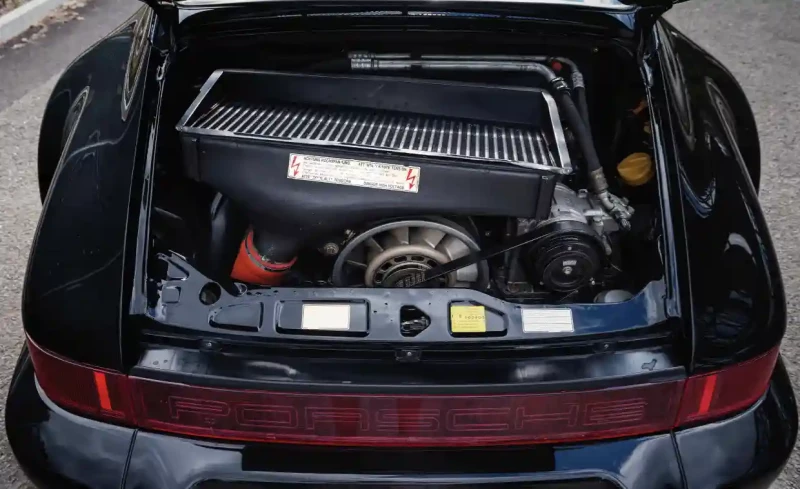
Above and below Alois Ruf Jr’s fingerprints can be seen throughout the cabin, highlighting the fact this is no ordinary 911 964 Turbo. Below Bespoke six-speed transmission was a hallmark of many RUF creations and often came accompanied by the firm’s EKS clutch system.
EVERY BTR 3.8 USES A LIMITEDSLIP DIFFERENTIAL WITH A SUBSTANTIAL FORTY-PERCENT LOCKING RATIO
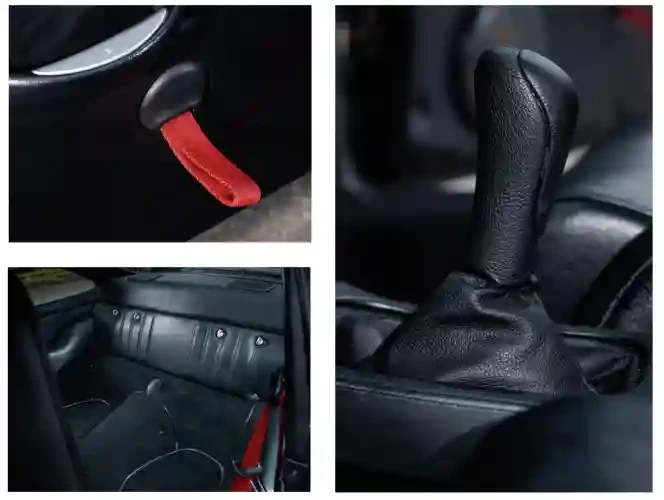
Above Partly due to the Will Smith movie, Bad Boys, the Turbo 3.6 became one of the most desirable of all 911s, although factory BTR 3.8s use the 964 Carrera 2 narrowbody shell as starting point. Facing page Originally a 964 Turbo 3.6, this wide-arched black beauty was converted to BTR 3.8 specification at RUF in Pfaffenhausen.


